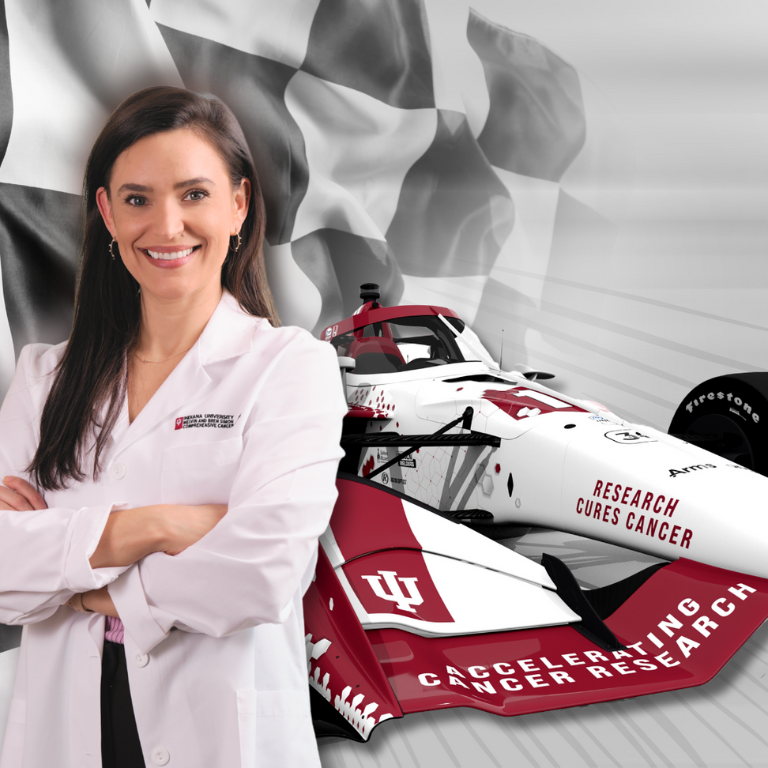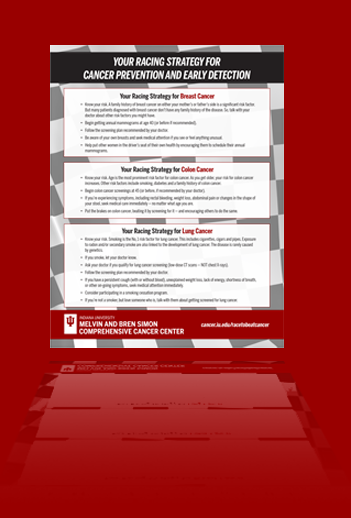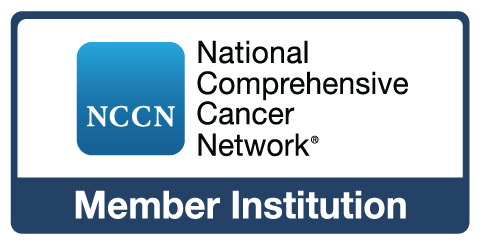Getting an annual mammogram.
It’s one of the most empowering things women can do when it comes to being the strongest advocates for their own health.
Deaths from breast cancer have decreased by almost 40 percent since 1990 — largely due to mammography and early detection. That fact alone is why every woman should have an annual mammogram.
Treatment options for breast cancer have improved significantly throughout the past several decades. However, early detection is still crucial to giving yourself every chance for a full recovery.
Schedule your annual mammogram. And tell the other women in your life to do the same.
Breast Cancer: Screening is Power
A Pit Stop with Tarah Ballinger, MD

From the depth of the relationships she forms with her patients to the progress she’s making in ending breast cancer, Dr. Tarah Ballinger is a champion. In her role as an oncologist at the cancer center and as a Vera Bradley Foundation Scholar in Breast Cancer Research, Dr. Ballinger is focused on providing individualized care to her patients. She’s particularly interested in breast cancer survivorship and the role physical activity and exercise can play when added to a patient’s treatment plan.
Most patients don’t have any symptoms, which is why screening mammograms are so important. But for those who do experience symptoms, these can include a firm lump under the skin that didn’t used to be there, abnormal dimpling in the breast or skin changes in the breast area.
The most common way breast cancer is detected is by mammogram. We now have 3D mammograms, which are more sensitive when it comes to finding breast cancer. In general, women should begin discussing the need for mammogram screening with their doctor by age 40. However, depending on their family history of breast cancer and other risk factors, some should start earlier and some may need additional screening. There’s no ‘one-size-fits-all’ when it comes to breast cancer screening. It’s something each woman should discuss with their doctor.
In addition to screening for breast cancer, women should also be aware of their breasts and advocate for themselves if they see or feel anything unusual.
Mammograms may be uncomfortable, but this is only temporary. It’s also worth it if you can detect a cancer earlier. Having to deal with more advanced cancer isn’t pleasant.
For those women who might be anxious about their annual mammogram because they’re afraid something might be detected, I encourage them to think of this screening as something that’s empowering rather than frightening. By getting your annual mammogram, you’re taking proactive steps to catch cancer earlier when it’s less life-threatening and easier to treat. Not getting your mammogram isn’t going to stop cancer from happening.
A family history of breast cancer on either your mother’s or father’s side is a very significant risk factor. Those who have first-degree relatives — such as a parent, sibling or child — who have had breast cancer are at a higher risk. In some cases, incidence of breast cancer in second-degree relatives can also increase risk. However, most women who develop breast cancer don’t have a family history of it.
Other risk factors include those related to lifestyle, such as alcohol consumption, obesity and being more sedentary. Hormonal factors — such as when you started and stopped having periods, when or if you were pregnant, whether you breastfed your baby, and whether you’ve taken hormones — can also have an impact. Breast density can also increase risk.
The more gland tissue you have in your breasts, the denser they are. This can make it harder for breast cancer to be detected by mammography. In addition, having more gland tissue means there are more cells to potentially make breast cancer. If a woman’s breasts are determined to be very dense, breast MRIs and/or ultrasounds may be recommended in addition to mammography.
In fact, for those diagnosed with Stage I breast cancer, the survival rate is the same as someone who has never had breast cancer. This is why early detection is so important.
Tarah Ballinger, MD
Lifestyle really does matter. For example, I tell my patients that engaging in physical activity is like taking a medication to help prevent breast cancer. Every time you take a walk or go to the gym, it’s like taking medicine that can lower your risk of breast cancer, in addition to other health conditions.
Eating a healthy diet and maintaining a healthy body weight are really important. So is cutting down on alcohol consumption. Anything beyond three to five drinks per week can increase the risk of breast cancer.
For high-risk patients, a low dose of a medication called Tamoxifen can be used to help reduce the risk of breast cancer. It’s typically well-tolerated and is very effective.
Treatment depends on the stage of the cancer at the time it’s detected.
For Stage I, patients typically have a lumpectomy followed by radiation. In some cases, chemotherapy is also administered. Anti-estrogen medication might be prescribed for several years to prevent recurrence.
With Stage II and Stage III breast cancers, more extensive surgery is needed — as well as more aggressive chemotherapy in some cases.
Stage IV breast cancer means the cancer has spread to other parts of the body. The focus at this stage is on keeping things under control and preventing growth of the cancer for as long as possible. This is often done with targeted medications or chemotherapies.
We’ve come such a long way in terms of treatments for breast cancer. It’s something we can deal with. It’s not a death sentence. In fact, for those diagnosed with Stage I breast cancer, the survival rate is the same as someone who has never had breast cancer. This is why early detection is so important.
I’ve always been interested in women’s health, and I like the breast cancer community. It’s a great example of how women have come together to raise money and push for advancements in research to improve health outcomes.
There’s such a broad spectrum of what breast cancer looks like. I enjoy caring for all phases of the disease. I also get to follow some of the same patients for years and really get to know them.
Leaving Breast Cancer in the Rearview Mirror
At the Vera Bradley Foundation Center for Breast Cancer Research at the IU Simon Comprehensive Cancer Center, teams of experts are working to find ways to treat breast cancer and, ultimately, to prevent it from occurring at all.
Areas of research include immunotherapy, precision genomics, prevention and detection, health equity and survivorship.
Current studies include those exploring:
- The cellular mechanisms of toxicities in aromatase inhibitors, which prevent estrogen-hungry tumors from developing.
- The benefits of exercise for women who have been diagnosed with early-stage breast cancer.
- The role body weight plays in cancer recurrence and death.
- How to better support those dealing with the fear of cancer recurrence.
- Using a patient’s own immune system to fight triple-negative breast cancer.
- Developing personalized therapies to target even the toughest tumors.
- Ways to reduce breast density.
- Understanding the role race and ethnicity play in treatment outcomes.
Every aspect of breast cancer treatment and prevention is being examined by researchers at the IU Simon Comprehensive Cancer Center. And they’re determined to leave breast cancer in the rearview mirror.
Racing Highlights
- Breast cancer researchers at Indiana University collaborate with other global leaders in this field, including the National Cancer Institute, Big Ten Cancer Research Consortium and the Hoosier Cancer Research Network.
- Since 2004, more than 1,300 discoveries have been published in peer-reviewed journals by IU breast cancer researchers.
Your Racing Strategy for Breast Cancer
- Know your risk. A family history of breast cancer on either your mother’s or father’s side is a significant risk factor. But many patients diagnosed with breast cancer don’t have any family history of the disease. So, talk with your doctor about other risk factors you might have.
- Begin getting annual mammograms at age 40 (or before if recommended).
- Follow the screening plan recommended by your doctor.
- Be aware of your own breasts and seek medical attention if you see or feel anything unusual.
- Help put other women in the driver’s seat of their own health by encouraging them to schedule their annual mammograms.
Please complete the form to access a downloadable version of “Your Racing Strategies for Cancer Prevention and Early Detection.” Take a victory lap when you share it with your family and friends.






